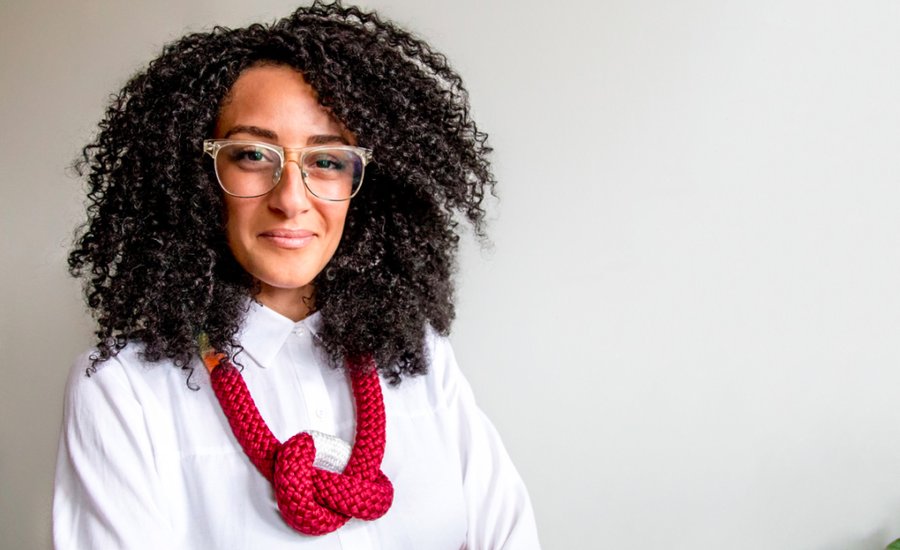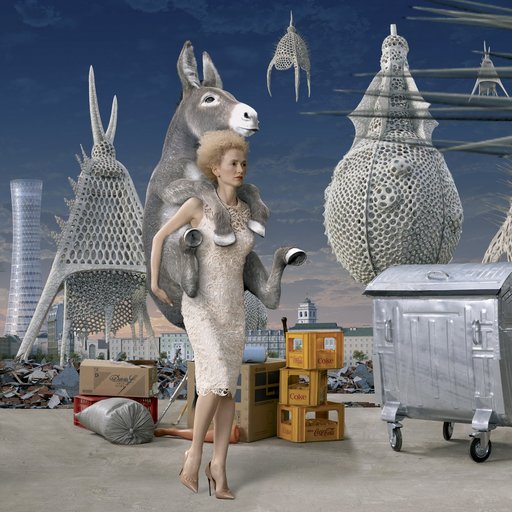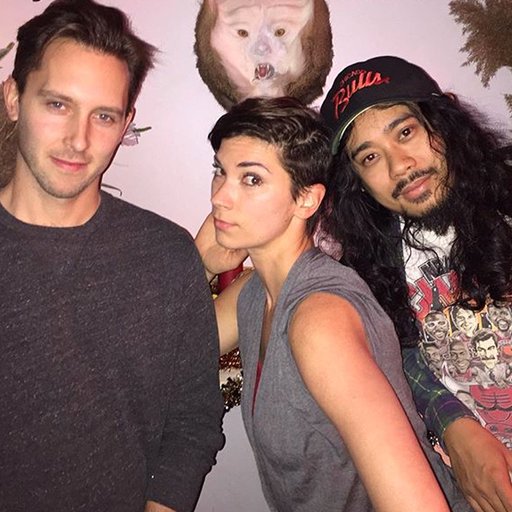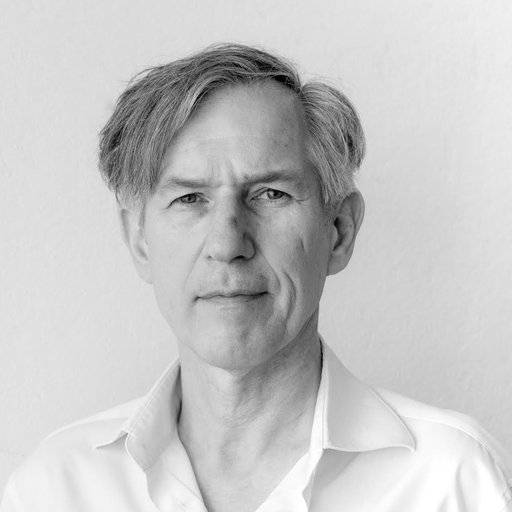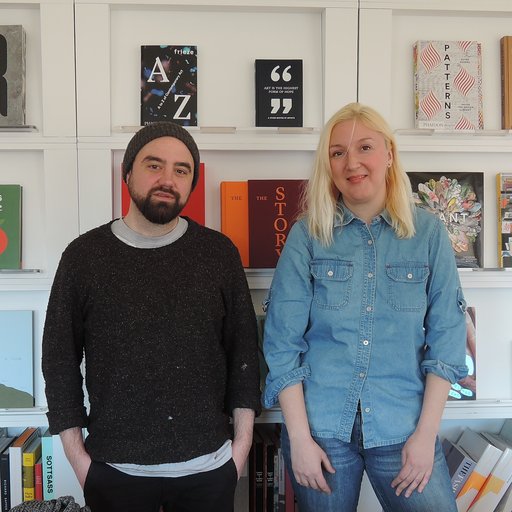Deana Haggag’s optimistic faith in the power of art and the value of artists is so sincerely genuine, it’s almost hard to believe she comes from a generation known for its cool retreat into irony and cynicism. At 30 years old, Haggag became president and CEO of United States Artists (USA) just as the organization turned ten, and just after Trump became president of a different USA. Awarding 50 artists each $50,000 every year, USA provides a service to artists that the National Endowment for the Arts (NEA) under Trump no longer can.
For the artist fellows who receive these unrestricted funds—who work in all artistic disciplines and hail from all corners of the country—these grants could mean the ability to experiment with a new, less-salable medium, or it could mean finally getting an overdue surgery that was previously unaffordable uninsured. But most importantly for Haggag, funding artists also means making space for visual stories about what it means to be American, however defined, during a time when both nationalism and anti-patriotism are at all-time highs. Last month, USA held its annual Artists Assembly in Chicago to honor the 50 fellows of 2016, and to give past and present fellows the opportunity to present their work to the press, to their donors, and at times, to the public.
After meeting Haggag, it’s not very difficult to imagine why USA hired her; for whatever she lacks in experience she makes up in enthusiasm for the dedicated support of American artists—and her willingness to ask the "big" questions while humbly admitting she might not have the answers. Before heading up USA, Haggag elevated a failing roaming museum in Baltimore to the successful and celebrated Contemporary that it is today—a feat for anyone, let alone someone straight out of graduate school. Artspace’s editor-in-chief Loney Abrams met with Haggag in Chicago to discuss the disconnect between arts appreciation and artist appreciation, about what it’s like to be a 30-year-old woman “USA president” during the Trump administration, and about how to bleed arts into the mainstream veins of American culture.
How does getting a USA fellowship change an artist’s life and what do the artists generally spend their money on?
In one case, two lesbians used the money to make a baby. They couldn't afford the kind of in-vitro treatment before, so in a way, USA actually made a baby! Some people use it to make more art, or pay off college for their kids, pay medical debt, buy a house, buy a long vacation, buy expensive equipment like kilns and ovens. I think it’s so beautiful. The money carries a totally different weight for a filmmaker than for a writer; $50,000 scales depending on context. I think that that’s something we’ve been thinking about a lot. Fifty grand in Sitka, Alaska is totally different than 50 grand in Miami, Florida, than in New York, or Chicago. What does that mean? For us it is really interesting. I don’t know if we’ll have solutions to any of that stuff, I don’t know if we ever could, but it’s important to think about a broad American artist class, and what it means to make things all over the country.
Also, getting a USA grant is obviously a huge honor and a privilege, but in other ways, getting a big grant makes you have to think about the tax code and how, in some cases, the increase in income means that maybe your kid who was on a certain financial aid plan in college is no longer eligible for their benefits, or that maybe you get bumped up to another tax bracket.
Why is the grant $50,000 for 50 artists and not $100,000 for 25 artists, or less money for more artists? To artists, is $50,000 the sweet spot?
We ask ourselves this question all the time. We just completed a 10-year impact study, which examines the processes of this organization. The reason USA was founded ten years ago was because the NEA stopped supporting individual artists. A decade later, the Urban Institute did a study to identify the major problems artists face today. On the top of that list was access to unrestricted funding. So, a number of foundations rose $25,000,000 in seed funding that found United States Artists. I think at that point they were really trying to be, in comparison to and in unison with other fellowship models around the country, the only one that was entirely unrestricted, nationwide, and across disciplines. At that point, 50 grand for 50 artists made sense.
Now 10 years later we are looking at the metrics and we have to recognize that $50,000 in 2006 is totally different than $50,000 today. Should it be less money for 100 artists? Should it be the same amount of money for 100 artists? We have a small endowment, but we still fundraise pretty much every dollar. I would say that three quarters of our fellowships are still fundraised for. So, we have to go out and find the money, and I think this particular moment in our nation's federal relationship with the arts might be an opportunity to think about giving artists more money, or it is more artists less money? We are thinking about the economics and nothing that is carved in stone.
How will the current administration’s cuts to the NEA effect your organization?
If the NEA is defunded tomorrow and state’s arts councils face a challenge to even exist, can we in any way support that work or pick up some of the slack to make sure that artists are represented in their regions? We’re really thinking about that right now. We were literally founded out of the previous cut to the NEA. I think our work will continue in the same ways it always has, which is that it will make sure that individual artists all over this country get funded.
A thing I love about USA is the diversity of the fellowship pool over the last 10 years. That is everything from age, race, socioeconomic background, gender identity, medium, geographic location, etc. I think that is so compelling as a narrative about who an American artist is today and has been for many, many, many years. I feel like we will continue to do this fellowship model and we will just amp up how we do that. For me, that means more visibility.
As we are talking about the NEA being defunded you’ve probably seen op-ed after op-ed about what a $148,000,000 arts budget really means. And those things are totally important to talk about and I think that they matter tremendously—but when you sit in a room with 15 artists who tell you what they make and you identify with the stories that they know, your understanding of arts funding changes. I'm curious about how USA can tell you artists’ stories and in turn tell you American stories about how people actually live day-to-day.
I don't know yet what other programs will emerge from the NEA’s defunding if that happens. I think that we are all thinking about it—the staff, the board, the alumni council, fellows—but I know immediately that USA, along with many other organizations like Creative Capital and Alliance of Artists Communities, really wants to step up and show Americans what the value of an artist is to society.
One of the great parts of that Urban Institute's study was the finding that 96% of Americans value art, but only 27% value artists. That does not compute in the world. A tremendous amount of Americans will tell you the value of art in whatever way they define it (they love music, dance, and museums), but never think about the individual behind it. We are not thinking about the kind of labor artists are putting into sharing their work with us. I am really curious about that. How do we make Americans, not closer to the value of art in this broad sense, but closer literally to artists as a part of their citizenship community? That is something that we are grappling with and something that I want to be very clear about. Even Artists Assembly is a very private thing right now—do we open that up a little bit? I think that people should really see some of those stories.
How important is it that USA grants remain unrestricted? If you want to get more visibility, you could ask artists to use their money specifically for public-facing projects—which would help get some of this exposure you’re hoping for, but would also mean restricting artist in how they use the money.
Yeah, for us it is really important to keep the funds totally unrestricted. Some of the people we fund are currently working on something really big that is public facing, and some aren't. I think that we want to keep it broad in that way. For example, Barry Jenkins was a fellow of ours in 2012 when he was thinking about Moonlight. He was making a film about the black queer experience and being in Miami, and that was a narrative that no major production company was ever going to fund. But he did it tiny grant by tiny grant at a time, with sweat and labor, and won three Oscars.
What is it to value having that narrative in the American mainstream? I never grew up with a film about black male queerness as it also relates to socioeconomics and being from the region of Miami! I feel like Barry's story is infinitely as important as the product that he has provided the American public. I feel like USA can be the place that tells more of those stories while we are waiting for them to seep more and more and more into the mainstream.
The reason that I took this job was because of the fellowship pool. I kept thinking about diversity in the sector; we strive for it, but to see it is a totally different thing. USA has always been really intentional about funding a wide geography. We knew about Barry Jenkins long before he became a thing. There are ways we are thinking about narratives that are not immediately on the forefront, and if artists don't happen to be working on something major right now or ever again, we think that whatever it was that compelled them to get here is an important enough narrative. For instance, Lynn Hershman Leeson—the things she is doing with technology will blow your mind! She has been doing that for 50 fucking years! She literally pioneered the use of new technologies in art, as a woman; she is remarkable. I feel like we could have found her sooner so people could have known about her sooner.
How do you find these artists? I know that they are nominated, but whom are you asking for nominations from?
We usually do a wide sweep; from my understanding it is about 1,000 people. We ask everyone from former fellows, former nominees, writers, curators, and various cultural professionals of every capacity. After we ask 1,000 people for nominations, we invite all of those artists to apply and work with them on their applications, and then we categorize them among panels and meet annually to make the final selections. It’s a long process that takes months. I think very little has shifted about the process since USA started. And now we are in a place where we are really thinking about it. We have these nine mediums. Why have those nine disciplines as the rest of the world has shifted away from them? I can't help but feel like most artists are not clearly visual artists but are also dancers, for example, or they’re not clearly just in theater, they are also in literature. Trying to make space to be flexible and nimble to whatever artists need is important.
Do donors have any say in who becomes a fellow?
Yes and no. Donors don't have a say in the sense that they can say, “This one particular artist I want to win it,” but we do have funding that is specific to a region or a discipline. Certain foundations only fund film, or certain foundations are only fund the greater Boston region. It’s beautiful if someone wants to fund an artist and we never want to discourage that, but we are also trying to make sure that we have experts on the panels who make decisions in ways that are free and open. I moved here from Baltimore to take this job and I have amazing relationships with Baltimore donors and I keep thinking: Can I just go to some of these people and ask them to help us make more of this possible? But they're more compelled to support their own community. That is an important thing, but how can that regional support exist and at the same time, help our open and free fellowship model that encompasses the entire United States? There is a constant negotiation.
Do you have any advice for people who want to support artists (which is apparently only 27% of the population!) but who don’t have much money? Do you have to be a millionaire to support the arts?
I think if you want to support the arts, the first thing to do is attend the arts. These things matter tremendously, actually. It matters a lot to whoever is advocating for an art show, or theater production, or whatever. If it is empty, it is impossible to save. Just attending the thing shows that that thing is worth funding.
I would also argue that even $5 makes a difference in the eyes of some nonprofit or some theater. But if you don't have any money at all, bring someone with you that wouldn't normally go to that thing. I’ve been trying to do that as an exercise for myself. I’ve realized my world is totally divided between my art world and my everyone-else world. How do we start to bring those two places together? My brother is not necessarily someone who is versed in the arts and goes to art events. I know that if I brought him to certain things he would be like, “What in the actual fucking good god is this?” Then there are other things that he would be totally compelled by. I am trying to always bring someone with me who maybe would recognize later that this thing matters. One thing that has been super beautiful about USA donor base is that every once in awhile there is a donor who brings a friend who had no idea what artists are doing, or how thoughtfully people are working. They get really excited about it and then they end up supporting it slowly but surely. Now we need the narrative to shift, to focus on this idea that art matters for Americans. You should bring friends that think that art doesn't matter.
They had an amazing talk at the Contemporary last year where we asked Jerry Saltz to be in conversation with a stand up comedian [Stavros Halkias] that thought contemporary art was bullshit. The comedian walked around museums and did a bit that was really funny. But then there was a really tender moment when he came across a Felix Gonzalez Torres piece and completely lost it. He was just like, “Man, I saw myself in that piece, I saw my partner in that piece. I just didn't know that that’s what a pile of candy, or fucking pillow was about!” There were moments when he was challenging Jerry on some assumptions that were really important and I think there were folks in the audience who really appreciated that. Some people don’t feel comfortable around art because it makes them feel really dumb. Stavros was like, “You’re not the one who is dumb. Maybe the thing is dumb.” Then Jerry would say, “Let's pull back; why does someone even take the time to make this thing? Let's talk about that.” It was so beautiful. I'm trying to think of ways to do that—to bring people with us.
Have you been following the Dana Schutz thing [the controversy surrounding the inclusion of Dana Shultz’s painting of Emmett Till in the Whitney Biennial]? It was on The View yesterday. Did you watch that?
I saw that!
Where she [Joy Behar] says that the NEA gets defunded because they don't want us to think. Painting is also an act of war. I was like, “What! On The View! This is hitting the mainstream!” Art is what gets people to stand the fuck up. Someone needs to bring all of middle America into this conversation about what art can do. I think that is so important.
Just switching gears a little bit, you just recently got this job. You are 30 years old. What had you been up to before this that landed you this great job?
How the hell did I get here at 30? I think about that a lot. I have no idea. I’m trying to be more generous with myself about that. I'm trying to learn from a lot of women who I feel have absolutely no idea how they've gotten to any place they've gotten. Loney, you’re all of a sudden an editor-in-chief and you’re, I imagine, also grappling with what that responsibility is and what does it mean and how do you carry yourself! I used to think that I was just in the right place at the right time, far too accidently.
I went to graduate school in Baltimore, and leaving New York was a really big decision for me. I went to a program that was not one of the ones I thought I would be in, which were basically all in New York or L.A. or, well, Bard. That was really important and really big for me. In Baltimore I felt like I was able to access certain opportunities in a way that I couldn't do in a much larger city, for a number of reasons. First, those opportunities were more available because there was less competition, but also I got to think about things a lot more thoughtfully. I don't think it's for everyone, but for me, getting out of New York was helpful. When I was in graduate school I became really obsessed with thinking about how art operates outside of traditional institutions, and my director in graduate school founded the Contemporary Museum in Baltimore, which is nomadic. It had folded while I was there and he had recommended I take a sort of fellowship opportunity with that board to decide whether or not the museum would reopen, and if so, whether they would move into a permanent building or continue to operate nomadically. One thing lead to another and somehow in that process I ended up being the director of this tiny, flailing museum. In my mind I see that as right place and right time; it just all aligned.
We did a good job, we had a great team, we hired an amazing staff, and had a really, really supportive board and amazing board chair. I think those things matter a lot. The museum grew very quickly and very steadily and in really beautiful ways. I think that helped my reputation a little bit. To be frank, one of the presidents of MICA, which is the art school I went to, is on the board at USA, and when there was a vacancy here he sort of threw my name into a pot and was like, “She’s really young and maybe she can't actually do this, but she’s a different kind of candidate.” My first conversation with USA was immediately after the election and it really influenced the conversation. I didn't think I had anything to lose because I never thought I would get this job because I was a baby. They were looking for somebody who had 15 years of experience; I don't even have 15 years of consciousness! But I just felt really energized and distraught by the election and I felt like I spoke frankly about what I think art should do and they offered me the job fairly shortly thereafter. I kept thinking this is also the right place at the right time.
A couple of month ago I was in the car with Katarina Llanes (who does some curatorial work around New York and Miami) and we were joking about being at the right place at the right time. She said, “I don't really know if that’s true. I feel like people just put out a certain energy and it comes back.” I kept thinking: if I took myself out of my ego and my insecurity about being at the right place at the right time, and I thought about it… I think that I'm not an artist, but I care about them so much and that’s actually really genuine. I feel that by not holding back and by really wanting to help support artists, this opportunity has come back to me in this weird way. I am so fortunate that this has been able to come back full circle and I have had the opportunities I've had to do this work.
Damn, what did you say in this interview with USA that made them want to hire you? What about the Trump election got you energized? What were your main concerns?
I think a lot of the interviewers were equally like, “What in the actual good god has just happened?” We were a group of people that didn’t not anticipate that it could happen, and yet we were entirely still surprised when it did. I think there were a lot of conversations about community, about protecting people, about what that even means. Also, I would love to mark here that they were literally interviewing a candidate to be president of an organization whose acronym is USA.
[Laughs.] Right, you are POTUSA.
Here we are all freaking out about what is it to even be in the USA. What does USA mean to undocumented people, what does it mean in a larger immigration context, and what is xenophobia? I think that this board, this beautiful board that has worked so hard to support individual artists, were now thinking about what is it to even be an American, let alone supporting American artists. They looked at the diversity of people we have funded and asked, “What if more people just knew about those artists? Couldn't we dismantle this disgusting rhetoric?”
One thing kept coming up in our interviews, which was how can we defend art today when so many other, seemingly more important thing are also falling apart—things like public health, housing, police brutality, and so many other issues? The way that I have started to think about this is that if all these issues were on a plank on a pirate ship, art would be the first to jump. I’ve watched arts slowly get defunded, and then a million other things fall back right after. I watched this in the Baltimore public schooling system—they cut art to balance the budget, and then a few months later they cut P.E. and then after P.E. it’s the science labs. It is a slow and steady thing. Art really is, unfortunately, the lowest hanging fruit. The way I think about that is: if we can protect our sector, we kind of carry everybody with us; we do our best to make sure that everything behind us stays intact.
Then we were thinking about how these artists we work with are making art about all of these different sectors—climate change, housing, prison systems, abolitionist work. If we can protect those artists then we’re also kind of adding to all of these other conversations that are happening within their communities. All of that was being worked out in this interview. It was a really beautiful, candid conversation with six grown adult Americans who were just like, “Oh my god, how did we get here, and is there a way to change it?” And we thought we needed a lot of unexpected thinking to solve these issues, and that maybe we should go right to the fellows who we are constantly rewarding for all of their unexpected thinking. All of that was so beautiful— and then I got the job. I was just like, “What?” I think I actually hung up on the board chair when he called. I couldn’t believe it.











